From the ceaseless cycle of cable news to the incessant activity of Instagram, the American public hardly lacks for pictures of the rich and famous. But in a culture driven by images, how well can most folks actually put names to faces when shown celebrities' pictures? Indeed, various segments of society may differ in their abilities to recognize powerful people: Are middle-aged folks better at identifying Joe Biden than Justin Bieber? If so, could the opposite be true for millennials?
These questions proved too intriguing to leave unanswered, so we decided to conduct the experiment ourselves. We asked 500 people to identify images of famous individuals from a number of industries, ranging from entertainment to tech entrepreneurship. Our results revealed which celebrities were most recognizable overall, and which luminaries were most likely to be misidentified. Our findings also revealed hilariously common mixups and embarrassing deficits in awareness. To find out which celebrity faces Americans can recognize most readily, keep reading.
Realms of Recognition
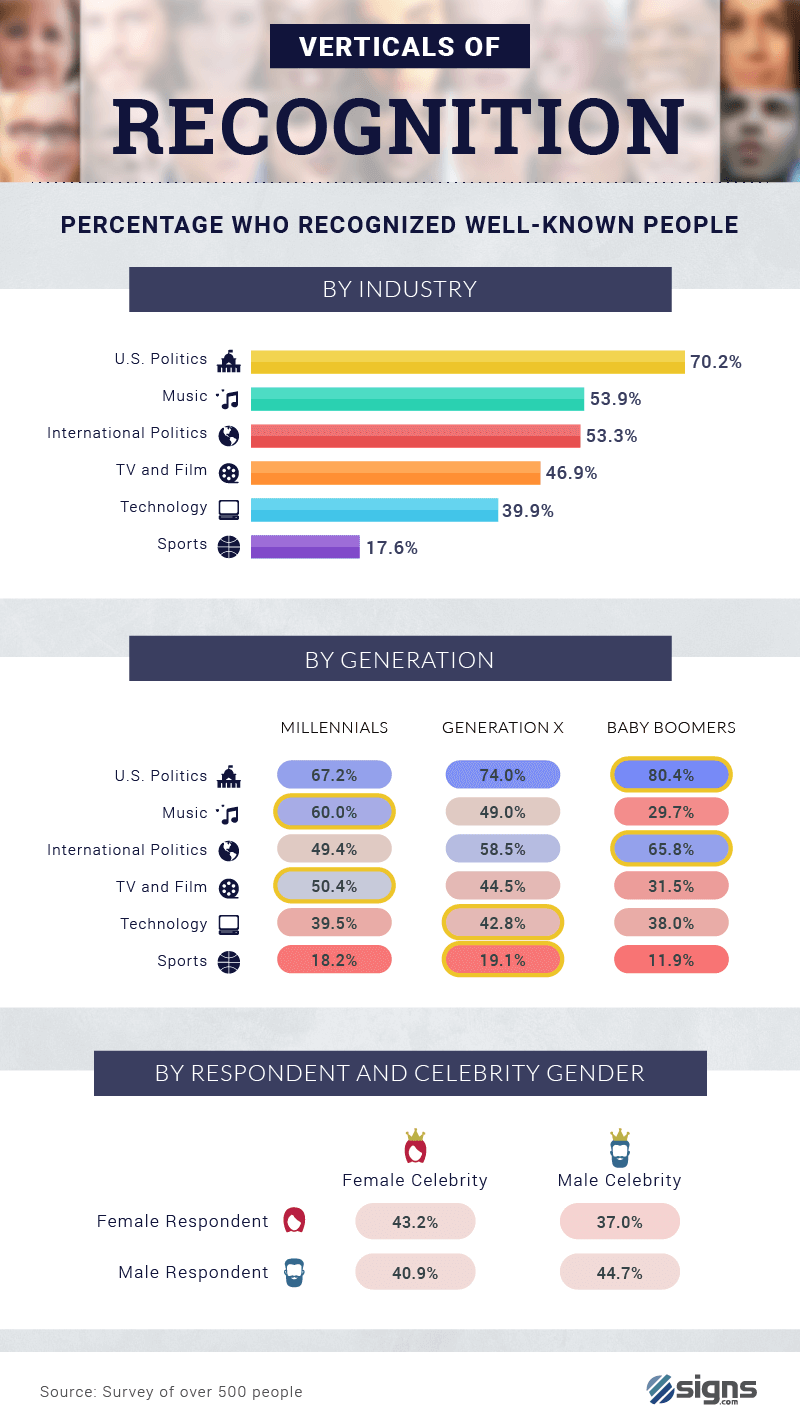
In comparing celebrity categories, politics emerged as the most recognizable domain. However, that finding was driven particularly by older individuals: Baby boomers were more successful than their millennial counterparts in naming politicians. The opposite was true for entertainers; recognition of actors and musical artists declined sharply with increased age in respondents. While these findings might affirm familiar criticisms of millennials' fixation upon fame, our data may simply reflect how people withdraw from pop culture as they grow older. Some studies suggest people stop discovering new music at age 30, for example, and stick to the tastes they've previously established.
Middle-aged respondents had their strong suit as well: While tech and sports had the least recognizable celebrity figures overall, Gen Xers were most successful in naming celebs from those industries. Differences related to gender also emerged, with men and women each slightly better at recognizing celebrities of their own sex. Of course, these results could reflect how certain kinds of celebrity coverage are often packaged in gendered ways. Just consider glossy magazines marketed to predominantly female readerships or the dearth of coverage for female athletes on male-centric television networks.
Theatrical Faces
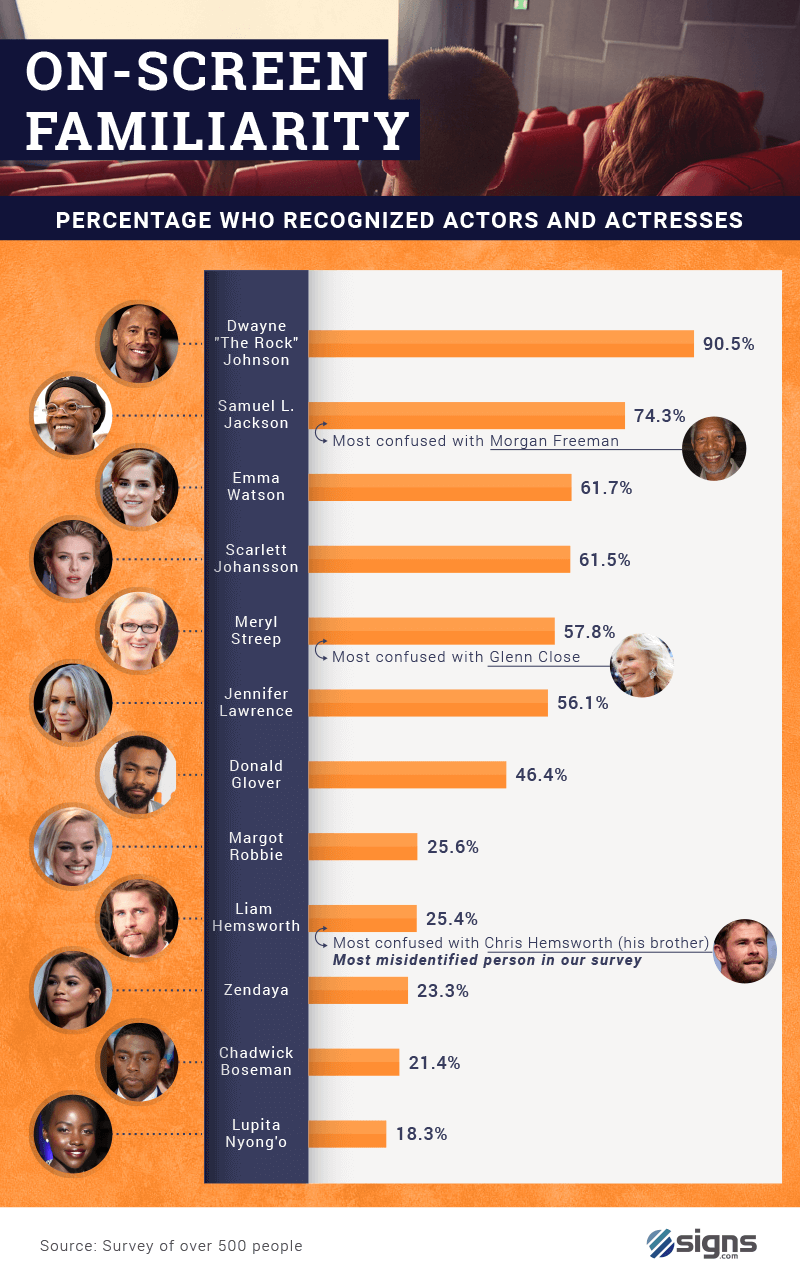
Even if you can't smell what The Rock is cooking, you can probably still recognize him: More than 9 in 10 people could identify Dwayne Johnson, whose action-packed career has made him one of the best-paid celebrities in the world. About three quarters of respondents were able to identify second-ranked Samuel L. Jackson, though he was misidentified with Morgan Freeman fairly often. That result might frustrate the Pulp Fiction actor, who has expressed his displeasure in the past at being confused for fellow actor Laurence Fishburne. Meryl Streep endured a similar misperception: Despite being recognized by most respondents, the master actress was frequently mistaken for another award-winning star – Glenn Close.
In other cases, the confusion was a bit more understandable: Liam Hemsworth was recognizable to only a quarter of respondents, but many mistook him for his brother, a fellow megastar. The least recognizable actors overall were Lupita Nyong'o, Chadwick Boseman, and Zendaya.
Visible Virtuosos
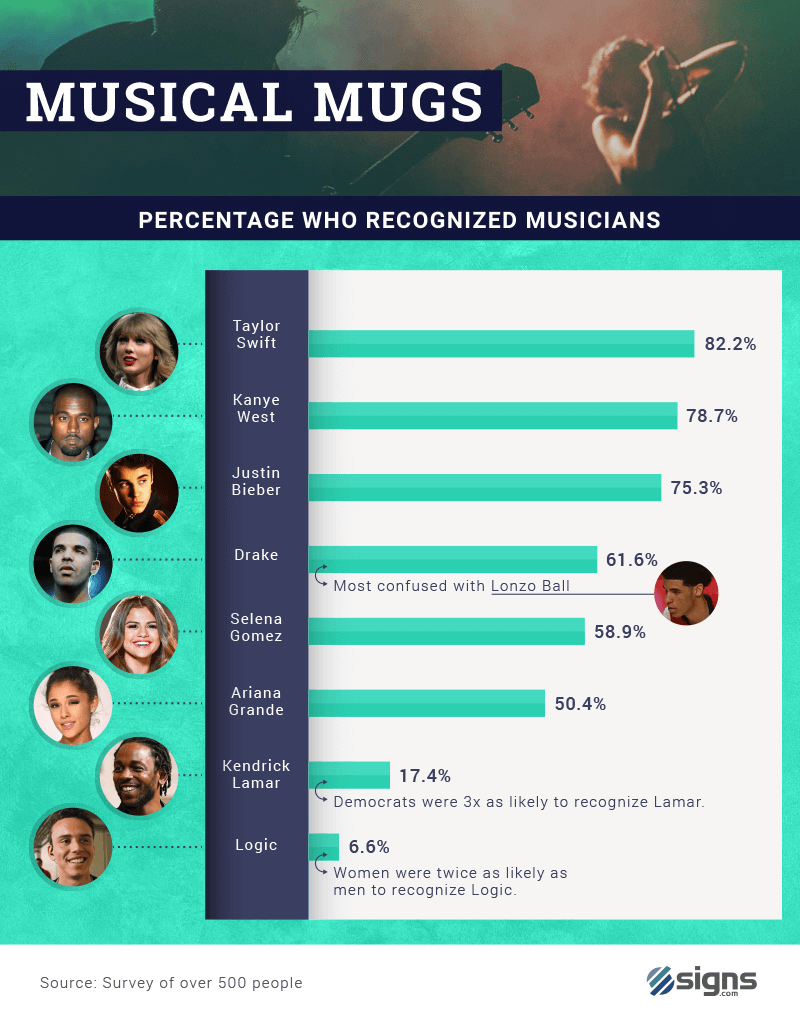
More than a decade after the release of her debut album, Taylor Swift's penchant for reinvention has made her an enduring presence in the charts and the most recognized musician in our data. In a fateful irony, the only artist to rival her visibility was Kanye West; the two have gone from feuding to friendly and back again since Ye infamously interrupted her MTV Video Music Award acceptance speech in 2009. Interestingly, the career of third-ranked Justin Bieber may represent a strange combination of Taylor and Kanye's experiences in the public eye. Like Swift, his stardom began in his teenage years, and like West, he's repeatedly met with problems in the public eye.
Other hip-hop artists did not fare as well as Kanye in terms of recognition. More than 6 in 10 people could identify Drake, but many also mistook him for Lonzo Ball, a comparison the NBA player apparently encounters pretty often. Kendrick Lamar was identified correctly somewhat infrequently, but Democrats were significantly more likely to name him accurately (after all, he does have a special connection with President Obama). Logic had even lower rates of recognition, though women were better able to identify him than men.
Look-Alike Legislators?
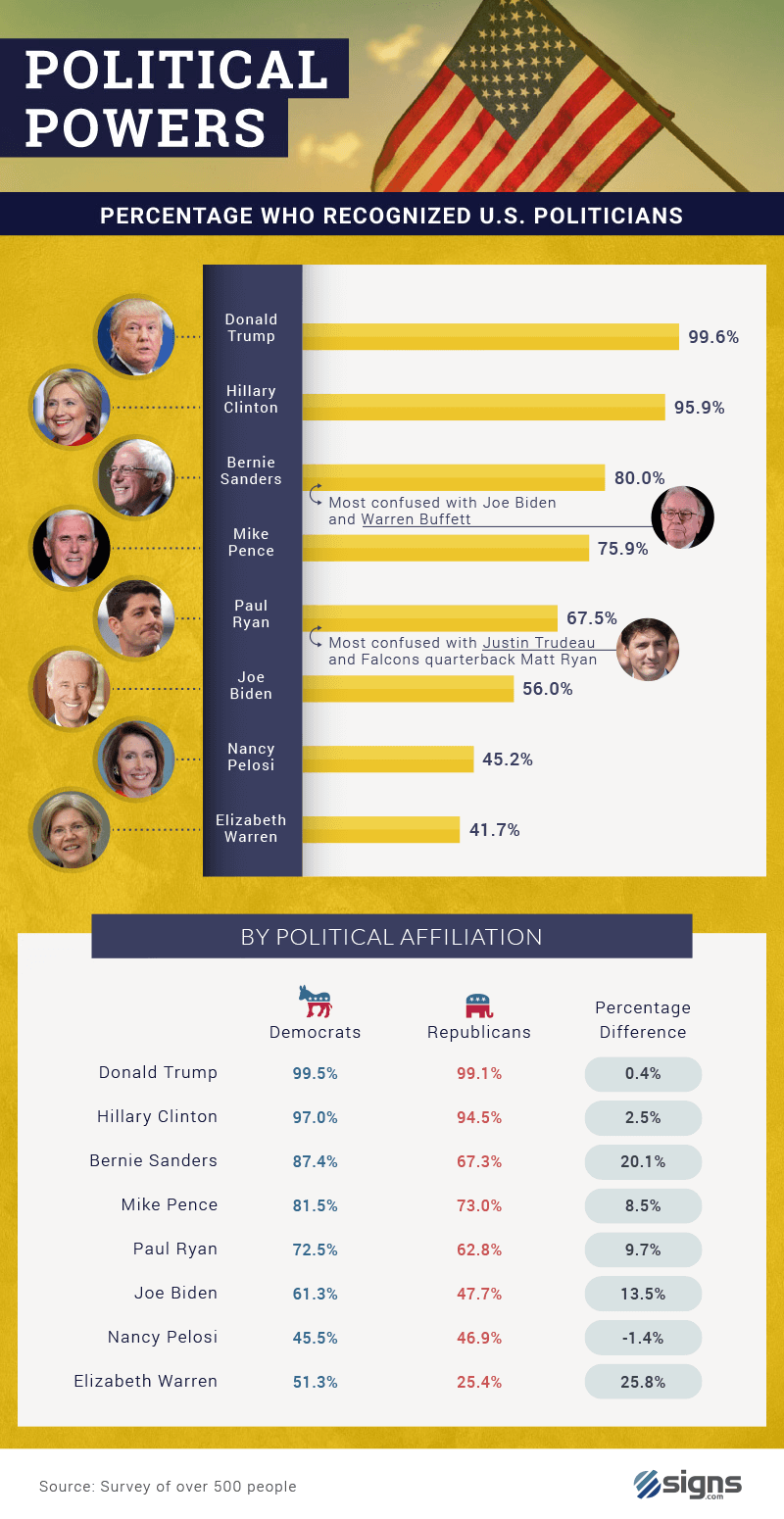
Though Donald Trump may criticize the tone of the media coverage he receives, there's no questioning its volume: Thanks in part to incessant reporting about the president, virtually every one of our respondents could identify him correctly. Nearly as many could name his main opponent in 2016, Hillary Clinton, but visibility for other politicians dropped off significantly from there. Bernie Sanders, who has charged that the media is too focused on Trump's daily activities, ranked a distant third with 80 percent identification. His recognition was far higher among Democrats, however, perhaps due to having competed for their presidential nomination in 2016.
Current members of the Republican power structure had more limited visibility: Just over three-quarters could name Vice President Mike Pence, and two-thirds could identify House Speaker Paul Ryan. The speaker was often confused for a certain NFL quarterback with whom he shares a last name, as well as Canadian Prime Minister Justin Trudeau (who wouldn't want to be confused with a world leader sometimes likened to a Disney prince?). High-profile Democrats were even less readily recognizable: Most people could not identify Nancy Pelosi or Elizabeth Warren. Interestingly, Pelosi was actually more recognizable to those aligned with Republicans than those with her own party, perhaps because she's been a frequent target of conservative scrutiny. She was also the only politician on either side of the aisle to be recognized more frequently by Republicans than Democrats.
Familiar Foreigners
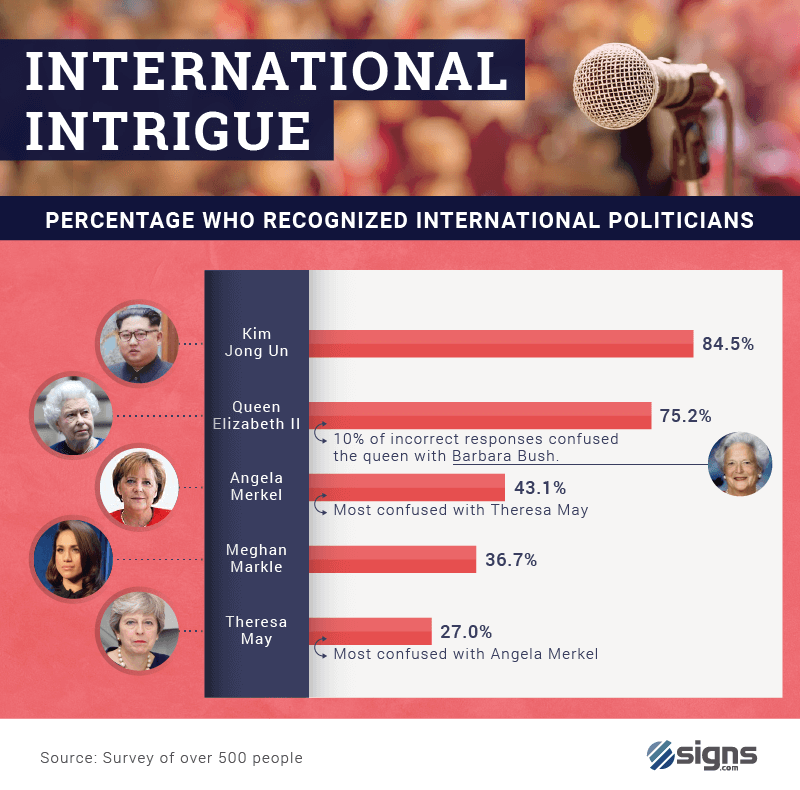
If Donald Trump is the most recognizable politician on the planet, his North Korean frenemy, Kim Jong Un, was the most identifiable foreign leader in our findings. The media has made much of the dictator's distinctive appearance in public settings, from his platform shoes to his swept-back hairstyle. In anyone knows how to dress for formal occasions, however, it's Queen Elizabeth II. Though three-quarters of respondents could correctly identify her majesty, a fair number confused her with former first lady Barbara Bush.
Other powerful people on the world stage were not so recognizable: Most people could not name German Chancellor Angela Merkel, and just over a quarter correctly identified British Prime Minister Theresa May. In fact, the two were often mistaken for each other. Perhaps more surprisingly, just 36 percent could accurately identify Meghan Markle. Despite extensive coverage of her nuptials and a prior career in television, Markle remained far less recognizable than her new grandmother-in-law.
Prominent Players
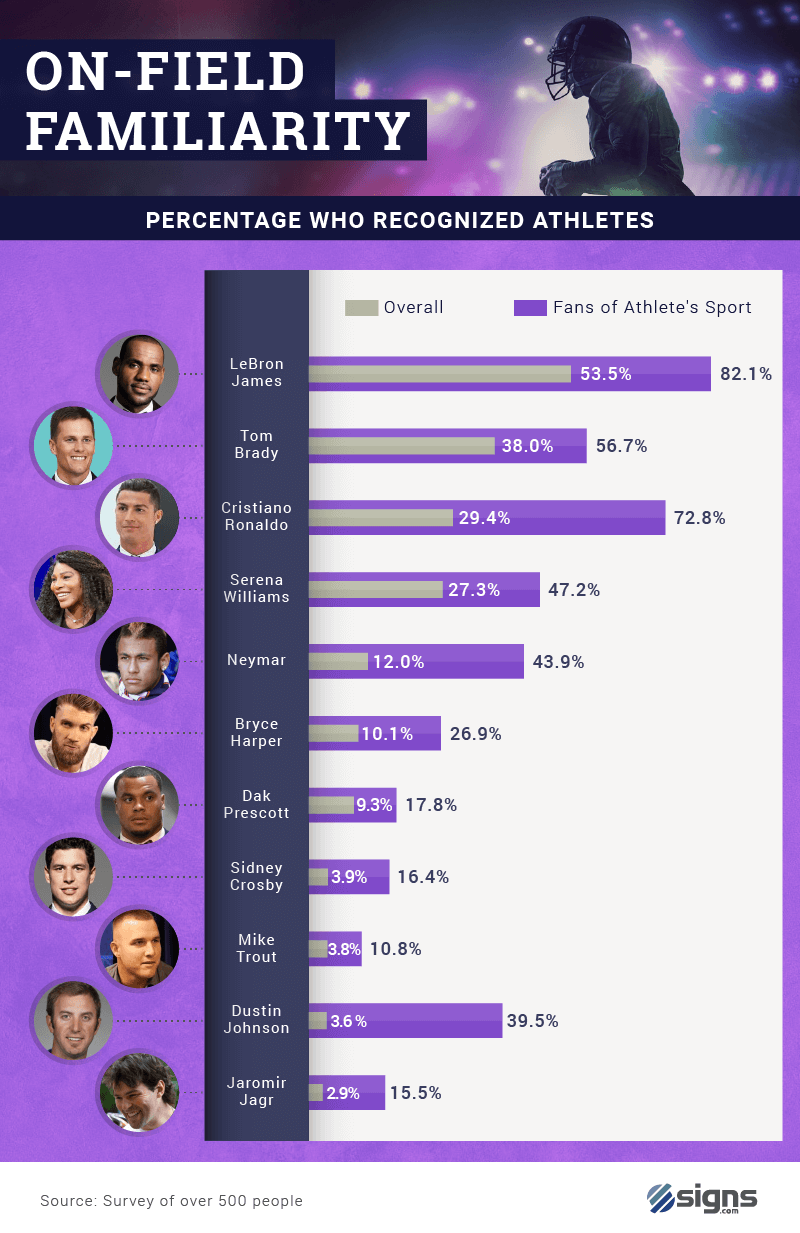
Some athletes transcended notoriety among fans of their sport and enjoyed broader recognition. One such star was LeBron James: He's not only the best-paid NBA player in history, but the only athlete on our list who was recognizable to most respondents. Tom Brady ranked a distant second, with merely 38 percent of all respondents identifying him correctly. The legendary QB may have a theory about why he's not more visible: He's attributed declining NFL viewership to the range of competing entertainment options available to modern consumers.
In other cases, limited recognition among the general public belied great familiarity among dedicated fans. For soccer stars Cristiano Ronaldo and Neymar, overall recognition was only a fraction of what it was among fans of their sport. Likewise, tennis star Serena Williams and dominant golfer Dustin Johnson were much better-known to those who followed their sports. In some cases, as was the case with hockey players Sidney Crosby and Jaromir Jagr, recognition was limited, even among fans – blame their helmets, perhaps.
Silicon Valley Visages
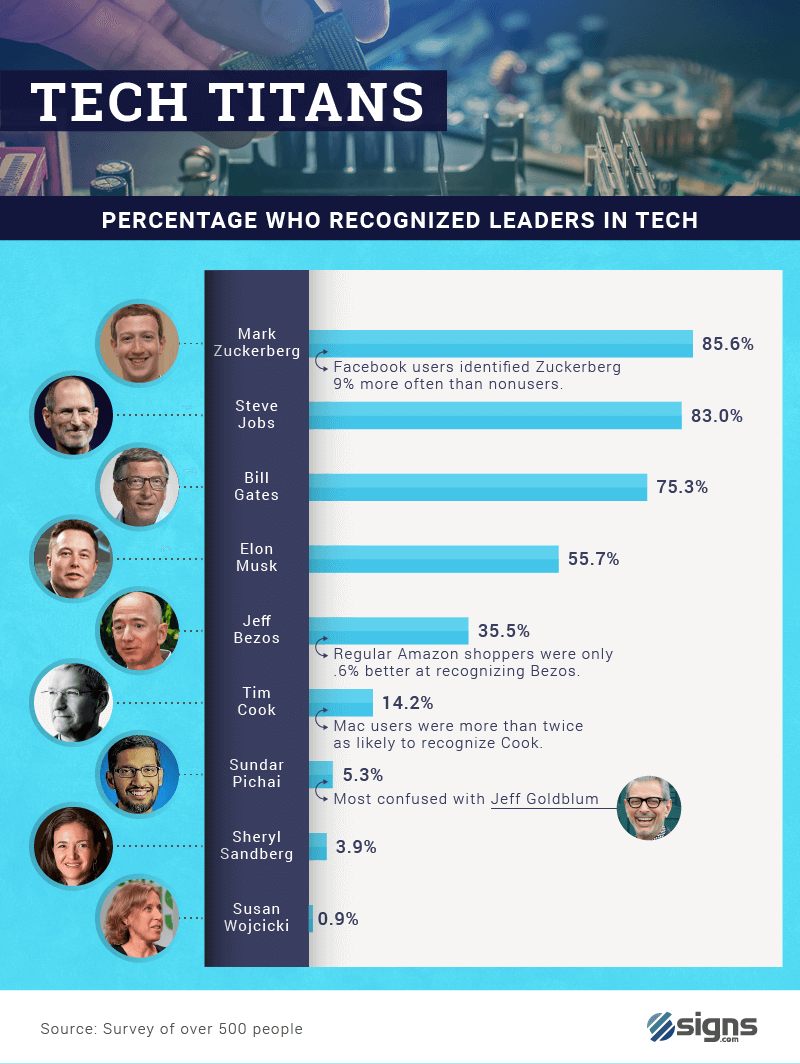
How visible were the people behind the devices and platforms that shape our digital lifestyles? In the case of Mark Zuckerberg, more than 85 percent of respondents could identify him correctly, a significant public profile for a noted introvert. Steve Jobs was nearly as recognizable: By delivering a series of notable keynote addresses in his uniform of black turtleneck and jeans, he solidified his place as a tech icon. His rival, Bill Gates, was correctly identified only slightly less often.
Other leaders of tech giants were far less recognizable: While Google may be ubiquitous, its CEO, Sundar Pichai, did not possess equivalent notoriety. More concerning, perhaps, was the limited recognition of some of Silicon Valley's most powerful women. Fewer than five percent of respondents could identify Sheryl Sandberg or Susan Wojcicki, both of whom have spoken powerfully about the ongoing need to address gender inequality in the tech industry. However, their public visibility clearly still lags far behind that of the field's most powerful men.
Raising Recognition
In many ways, our findings revealed where the American public's attention is most intensely focused. When actors, athletes and musical artists are more recognizable than many politicians and business leaders, for instance, our penchant for entertainment becomes obvious. But before we cast the entire culture as frivolous, it's worth noting that it's possible to expand our awareness at any time. Should we choose to better familiarize ourselves with another public realm, the internet makes that sort of inquiry quite easy. That's one aspect of modern media we can all appreciate, no matter which celebrity faces we prefer to see on our screens.
Try It Yourself
Think you can do better? Test your facial recognition skills with our interactive quiz below:
Methodology
To compile the data shown above, we showed 500 people a series of faces, and simply asked the question: Who is this person? We told them that Jeopardy rules apply – last names were acceptable. We then asked demographic information about participants, like the types of sports they liked or their online behaviors.
Because people's memories can be short, we erred on the side of generosity in accepting people's answers. Spelling mistakes and obvious indications of recognition were counted as correct. We also looked at the totality of people's answers and removed some respondents if they got only one or two correct to omit anyone who we didn't believe was being honest. Some answers were, let's just say, "creative." For these more creative responses, we looked at multiple factors in the answer in question and the respondents' other answers to determine, to the best of our ability, if they recognized the person or not.
About Signs.com
Some impressions simply need to be made in person, however. And unlike some celebrities, your business can't afford to go unrecognized by huge swaths of your target audience. Signs.com lets you declare what your business is all about with effective and attractive signage of all kinds. With our tools to customize your messaging and presentation, you'll never get ignored or confused for a competitor.
Fair Use Statement
Want to share our findings with your friends? You're free to do so for noncommercial purposes. Just do us one favor: When you share our work, link back to this page to credit our team. We may not be The Rock, but we do deserve a little recognition.
